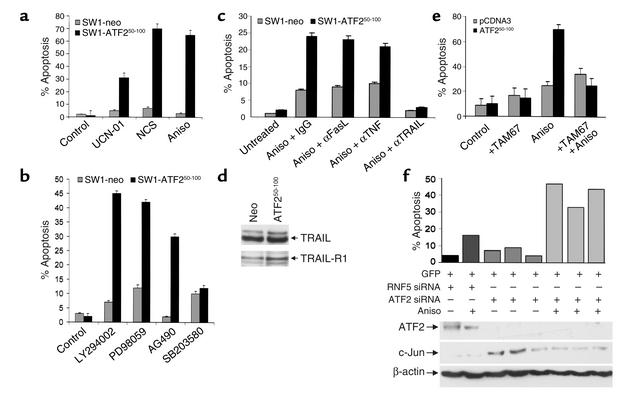Figure 3.
(a) Sensitization of ATF250–100 peptide–expressing SW1 melanoma cells to apoptosis. SW1 cells expressing the ATF250–100 peptide or control peptide were treated with the indicated drugs, followed by FACS analysis to measure the hypodiploid cell populations. (b) Sensitization of SW1 melanoma to apoptosis by inhibitors of specific signaling pathways. SW1 cells expressing the ATF250–100 peptide were treated with the pharmacological inhibitors indicated, followed by FACS analysis to reveal the percentage of apoptotic cells. (c) Inhibition of TRAIL abolishes sensitivity of ATF250–100–expressing SW1 cells to anisomycin-induced apoptosis. Control and ATF250–100–expressing SW1 cells were pretreated with neutralizing antibodies to FasL, TRAIL, or TNF. Twenty-four hours later, cells were subjected to anisomycin (Aniso) treatment, and degree of apoptosis was monitored via FACS analysis. (d) ATF250–100–expressing cells exhibit an increase in expression of TRAIL receptor. Western blot analysis using antibodies to TRAIL or TRAIL receptor 1 was performed on extracts prepared from the indicated cells. (e) Dominant negative c-Jun construct attenuates the sensitivity of SW1 cells to anisomycin-induced apoptosis. Control cells and SW1 cells expressing ATF2 peptide were transfected with a dominant negative form of c-Jun (TAM67), and cells were subjected to anisomycin treatment. Degree of apoptosis was monitored via FACS analysis. (f) ATF2-siRNA sensitizes SW1 cells to apoptosis. Cotransfection of ATF2-siRNA and green fluorescent protein was followed by treatment of cells with anisomycin and analysis of green fluorescent protein–positive cells for apoptosis via FACS. For the three experiments shown, P = 0.0039. UCN-01, UCN-01-7-hydroxystaurosporine; NCS, neocarzinostatin.

